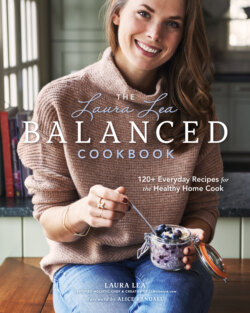Читать книгу The Laura Lea Balanced Cookbook - Laura Lea - Страница 33
На сайте Литреса книга снята с продажи.
ОглавлениеUNDERSTAND YOUR SKILLETS AND PANS
Skillet versus sauté pan. A skillet or
frying pan is shallow, with slanted sides
that flare out. A sauté pan has taller,
straight sides, with more surface area at
the bottom. Throughout this cookbook,
you will mainly “see” me using a stainless
steel sauté pan, because it is cleaner
(less sloshing over the side) and because
I think it can do everything a skillet can
do. However, if you already own a small
and a large skillet, don’t feel that you
need to get sauté pans as well. Your
skillets should work just fine.
Cast-iron skillets. A different animal
altogether, these classic heavy pans are
a great investment. They don’t cost a lot
and they get better with age, if properly
taken care of. Cast-iron takes a little
while to get hot, but it gets screaming
hot and has excellent heat retention. I
use my cast-iron skillet when I want to
make sure that the dish is cooked evenly
through, such as my Pesto Chicken &
Spinach Frittata (page 137) or Summer Peach & Blueberry Crumble with Coconut Cashew Cream (page 323). I also use it for nonstick cooking, like with my Customizable Oat Johnnycakes with 20-Minute Chia Berry Jam (page 118). “Seasoning” your cast-iron skillet protects it from heat and makes it durable.
To season cast-iron: Preheat oven to
325° F. Wipe down skillet with a wet cloth
and dry thoroughly. Apply a thin coat of
any oil of choice to the skillet (I use olive
oil). Place skillet upside down on center
oven rack, and place a sheet of aluminum
foil on bottom rack to catch dripping oil.
Bake for an hour, turn off oven heat, and
allow skillet to remain until completely
cooled. You’ll know you need to re-
season your skillet when it is no longer
smooth and shiny.
To clean your cast-iron skillet. Do not
wash with soap or scrub with a metal
brush or sponge; this will damage it.
Wash under hot water with a textured
sponge as soon as possible after cooking.
If this doesn’t clean it completely, add a
few tablespoons of sea salt and scrub the
salt into the skillet with a paper towel or
dish rag. Rinse thoroughly.
Green nonstick pan. Traditional nonstick
pans/skillets have been shown to release
toxic gases at high temperatures, making
them an unsafe option. However, some
companies are now making “green”
nonstick ceramic skillets that purport to
eliminate health concerns. I have one grill
pan from a company called GreenPan,
and I’ve used it successfully. If you would
prefer not to invest in a cast-iron skillet,
you can look into “green” or “eco” pans
to determine how you feel about them.
